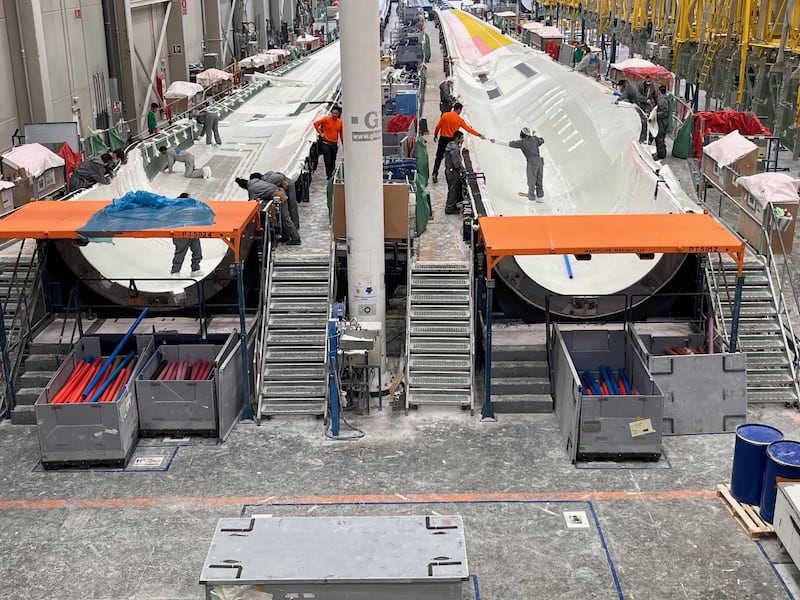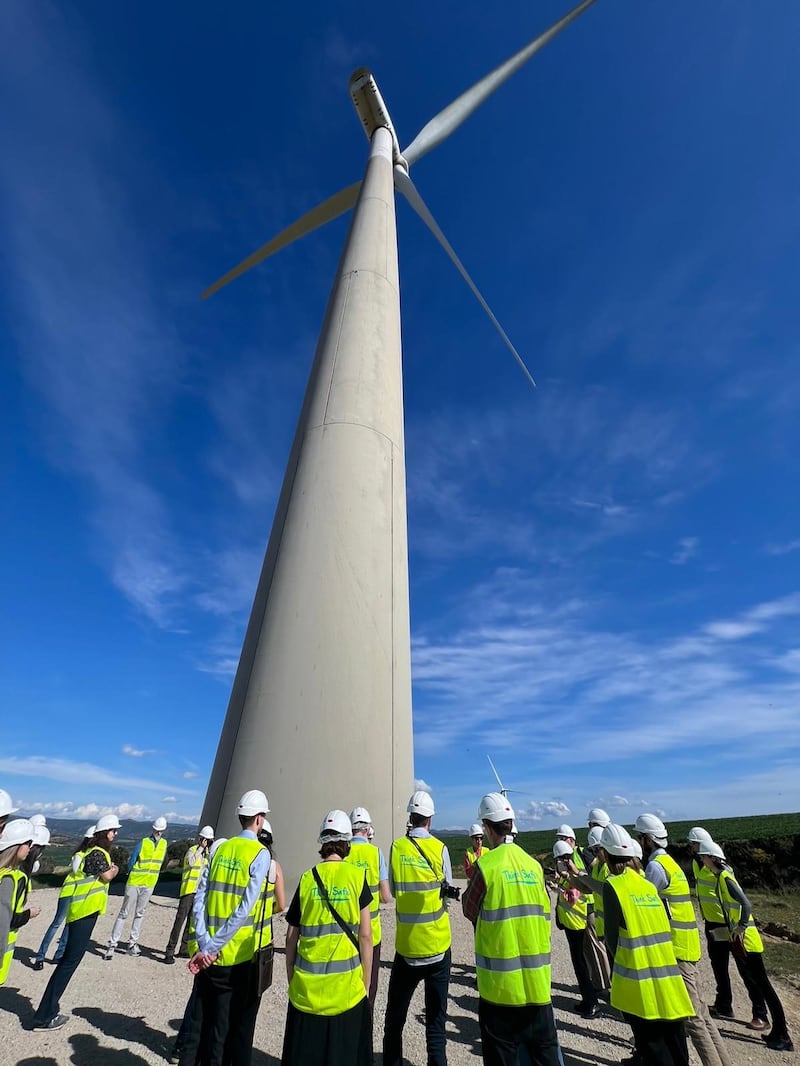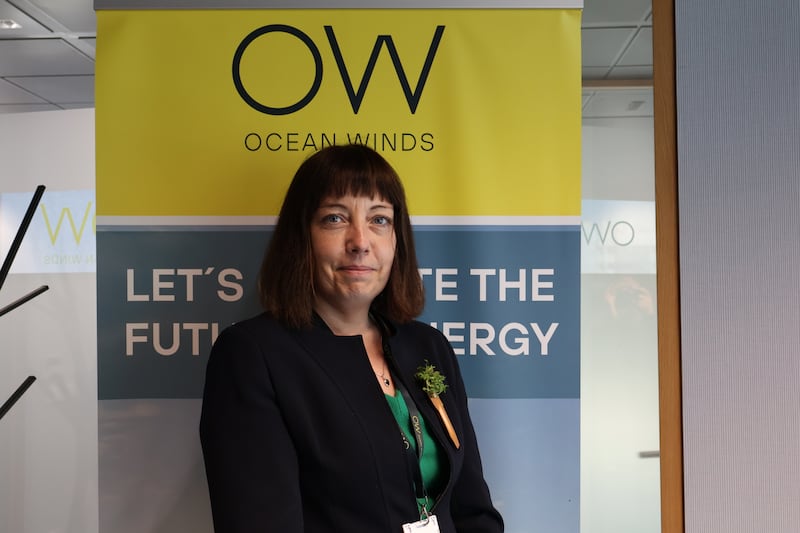“Seven years ago, where I’m standing was water.” The observation is a good indication of Bilbao port’s ambition and timely delivery of supporting infrastructure for its ever-growing renewable energy sector.
The 30-hectare site is a giant logistics hub operated by Toro y Betolaza, exporting large quantities of 40-tonne, 120m long turbine blades, towers and nacelles (the sophisticated engine rooms for wind generation, the size of a shipping container) – the products of advanced engineering made on its doorstep.
This is what being part of “the supply chain” looks like, explains managing director Gorka Zabala, noting it goes far beyond simply shipping stuff in and out.
An adjoining 40-hectare site is being provided to accommodate floating offshore wind farm expansion.
READ MORE
The expansionist mindset is evident in ports across northern Spain as scale-up is concentrated on the Bay of Biscay. Like Ireland, Spain is coming late to offshore wind, despite being a powerhouse in establishing European wind farms, second only to Germany.
Fixed-bottom turbines are attached to the seabed. They are the dominant offshore technology today – with lower cost and closer to shorelines. Deepwater floating turbines made of the same materials are anchored and are a rapidly maturing technology.
EU countries are outdoing themselves in unveiling ambitious offshore plans, and Ireland is up there with the best of them. Spain is committed to 3 gigawatts (GW) of floating offshore wind by 2030; Ireland is promising to have 5GW of installed fixed and 2GW of floating “in development” by decade end. One gigawatt is capable of powering 800,000 homes – a large city – and Ireland is planning to have 20GW by 2040 – mostly floating. Currently, there are only four commercial floating wind farms in the world.
Ireland may not have the might of Spain, but “the Irish Government is doing a very good job in ramping up their progress. They are quite rightly focused on seabed-fixed in the short-term,” according to Chris Williams, head of floating wind with German renewables company RWE.
“That’s low-hanging fruit. That helps build up a track record of deployment and allows the industry in Ireland to build up experience,” Williams adds. RWE is the world’s second-largest offshore generator and is involved in Dublin Array, a wind farm of almost 1GW being built off the Dublin-Wicklow coast.
“But there is finite capacity of seabed-fixed that can be built in Ireland,” Williams says. “So if Ireland wants to fulfil its long-term objectives, then floating wind has to be part of that. There are some incredibly attractive areas for floating wind; huge wind resources that we could deploy ... We need to work out where that load centre is and make sure the market dynamics are right for Ireland.”


During a visit to the Basque region, it is easy to detect coherence between industry: start-ups, innovators, advanced IT to maximise efficiency; ports and transporters in harnessing renewables. It is said “the north of Spain is wind”.
The history of the Nordex-Acciona manufacturing facility in Lumbier can be told by the increasing length of its turbine blades, now at 81.5m. Some 400 blades will be delivered across Europe this year from the plant employing 700 people.
Nearby in the Navarre region is the village of Barásoain. With a population of 620 people, it is beside an experimental wind farm run by Acciona, testing prototypes and materials, such as using concrete rather than steel. Wind turbines dominate mountaintops almost in every direction.
Public acceptance of onshore turbines may be low in parts of Europe but former Barásoain mayor Rita Roldan says relationships with the developer changed once they felt they were being listened to. “We were reassured agriculture and wind farms can coexist.”
The village receives €70,000 a year for community projects and is more prosperous than its neighbours, she says. On turbines dominating the skyline, current mayor Silvia Arrastia adds: “You get used to them. We prefer this to other infrastructure because it has a direct improvement on our lives.”
Tecnalia, a not-for-profit research and development company, is testing floating prototypes in Bilbao, pushing them to their limits and determining how to ensure stability in hostile seas.
A test platform has been put in place by Saitec Offshore Technologies off Bilbao. It proved to be “super stable” when Storm Ciaran battered northern Spain last November. It is a small 2 megawatt (MW) unit, but its data is already feeding into new 18MW designs that will be as high as the Eiffel Tower. There are 50 floating prototypes worldwide, of which 14 were developed in Spain.
Wind generates 19 per cent of Europe’s electricity. The EU wants to double it by 2030, with floating beginning to play a part. Analysis by industry body WindEurope shows this target is within reach. Investments are increasing as inflation has stabilised, while auction volumes – where state contracts are issued – are up.
European turbine manufacturers and suppliers are returning to profitability, says WindEurope chief executive Giles Dickson. “The supply chain is building new factories in Europe, and governments are actively supporting the wind industry, with the EU wind power package and European wind charter. Governments including Ireland are setting ambitious targets with lots of auctions – twice as many as last year – which ensures a bigger pipeline of projects.”
For the first time there was an Irish pavilion at WindEurope’s annual gathering attended by 12,000 delegates last week in Bilbao. This reflects what is happening in Ireland, Dickson says. “Industry looks at Ireland in a very positive light indeed. It likes the ambition. It likes the specific policy. It sees Ireland wants to do more. Its [new] industrial strategy is having an impact; it wants to be part of the supply chain, especially with offshore energy,” he says.
The political presence of Minister for Energy Eamon Ryan at the conference and an online briefing from Minister for Enterprise Simon Coveney on the strategy for offshore wind reinforces the message, he adds.
[ Pitching for a role servicing wind farms off the west coastOpens in new window ]
On lessons for Ireland from what Bilbao has become, Dickson says it stems from the Basque region taking a strategic decision almost 30 years ago. It doesn’t have many wind farms but has built up industrial know-how; “it continues to grow on that industrial policy. Ireland is making a similar statement.”
Ocean Winds, a pioneer of floating wind technology, has welcomed the first draft of offshore wind regulations for Spain issued recently. Owned by Portuguese company EDP Renewables and French company Engie, it has headquarters in Madrid – and is in a joint venture with Bord na Móna to develop offshore wind in Ireland.
Like Ireland, Spain is coming somewhat late to offshore renewables, says Ocean Winds Ireland manager Angela Larkin, but is taking a different path in pursuing 100 per cent floating due to its sea depth characteristics.
With Ireland now having a “plan-led” approach, she hopes the Government will soon identify an area off the south coast – known as a DMAP – for development, and another on the east coast, near where there is most power demand.


“In Ireland, we’re catching up in the last couple of years with regulation and policy similar to Spain,” Larkin says. A critical difference is Spain has a supply chain for fixed turbines by already supplying Europe’s offshore wind industry, making them well positioned to scale up floating projects.
“Ireland is different from Spain and unique. We have bottom-fixed potential on the east coast and south coast, which is less costly, and then the west coast is floating ... strategy is on focusing first on bottom-fixed. We’d be very supportive of that.”
Ocean Winds has analysed likely supply chain demand in Spain for the next decade and ensured fabrication capacity with suppliers. There are 143 offshore wind farm projects in the national pipeline.
When Ireland had a develop-led policy it selected two sites off Dublin and the south coast. “Overall, we support a plan-led model,” says Larkin. “[But] it’s really important for us that the Government stick to their timelines, I can’t overemphasise enough how important it is for investment certainty.”
Williams cautions against over-hype about floating wind energy when fixed-bed wind farms are happening at a vast scale, but it will be a globally important sector concentrated at key locations such as the northwest Atlantic including Ireland. And “because it’s an evolution and not a revolution”, he predicts it will emerge far quicker than the 20 years it took fixed to become proven technology.
- Listen to our Inside Politics Podcast for the latest analysis and chat
- Sign up for push alerts and have the best news, analysis and comment delivered directly to your phone
- Find The Irish Times on WhatsApp and stay up to date











